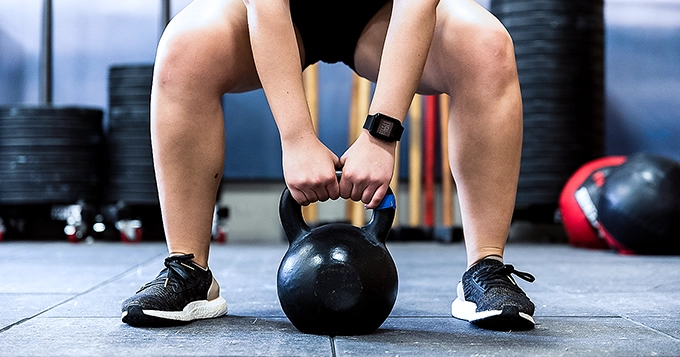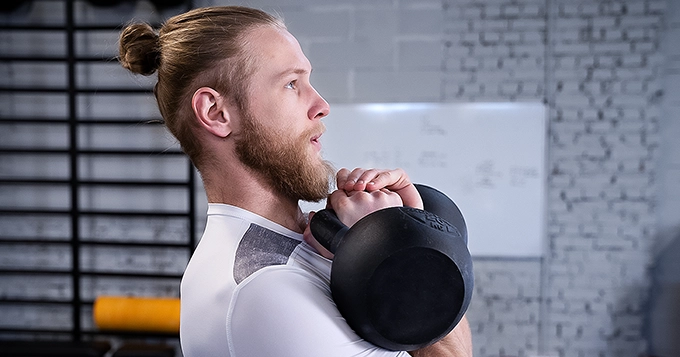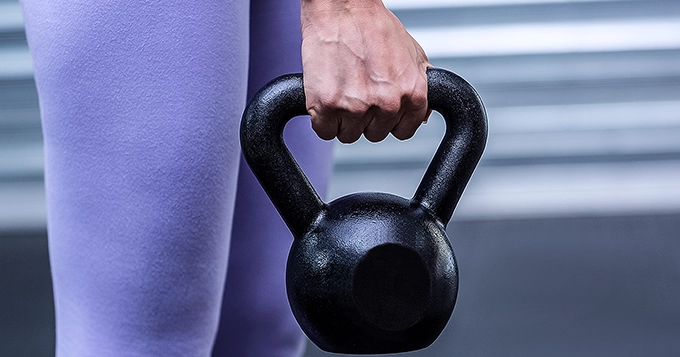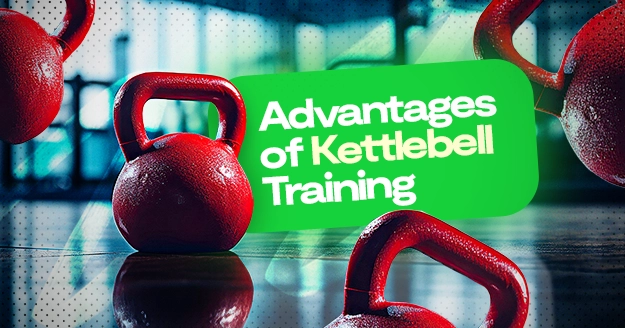The kettlebell is a versatile and effective tool for achieving overall health and strength. With its unique design and paired with dynamic movements, kettlebell training offers advantages for people of all fitness levels. Let’s delve into the plethora of benefits that kettlebell training can bring to your body.
Advantages of Kettlebell Workouts
-
Cardiovascular Fitness
Kettlebell training is a highly effective method for improving cardiovascular fitness. By incorporating dynamic movements like swings, snatches, and complexes into your workout routine, kettlebell exercises elevate the heart rate and stimulate the cardiovascular system.
This leads to increased oxygen consumption and enhanced circulation, ultimately improving the efficiency of your heart and lungs.
-
Functional Strength
Kettlebells are an excellent tool for developing a tight, lean body that emphasizes strength training over muscle growth. They work your glutes, lower back, and core particularly well. Although they can be used for deadlifting, kettlebells with lower weights are an easy and useful supplement to aerobic exercises.
Exercises with kettlebells imitate natural movements, making them very useful for daily tasks. The strength acquired from kettlebell training transfers straight into enhanced functionality and mobility in daily life, whether you’re playing with your kids or doing grocery shopping.
-
Joint Health and Flexibility
Kettlebell training not only enhances strength and cardiovascular fitness but also contributes significantly to joint health and flexibility.
The dynamic movements involved in kettlebell exercises promote an increased range of motion, helping to improve joint mobility and reduce stiffness. By engaging multiple muscle groups simultaneously, kettlebell workouts encourage better coordination and balance, which are essential for maintaining joint health.
You won’t be putting the same repetitive strain on your joints and connective tissue as you would with other cardio exercises like jogging because your feet stay grounded during even the most powerful kettlebell motions.
-
Core Stability
One advantage of kettlebells is it improves core stability.
Kettlebell exercises involve engaging and stabilizing the entire core, which includes the lower back, obliques, abs, and muscles surrounding the hips, such as the glutes. Because of the additional instability caused by the off-center weight distribution, the core muscles must work harder to keep the body balanced and under control.
-
Coordination
A lot of kettlebell exercises also engage the mind.
The dynamic and multi-dimensional movements involved in kettlebell exercises require concentration and precise coordination between various muscle groups, promoting better overall coordination.
Whether performing swings, cleans, snatches, or Turkish get-ups, each movement demands proper alignment, timing, and control.
As individuals progress in their kettlebell training, they develop a heightened sense of body awareness and proprioception, allowing them to execute movements with greater precision and efficiency.
-
Training Versatility
You can achieve a decent workout without having to drag yourself to the gym so early in the morning. One of the main advantages of kettlebells is the versatility that kettlebell training offers. With kettlebells, you can work out any place at any time that’s convenient for you.
But kettlebell’s versatility doesn’t end in its convenience.
Kettlebell training offers unparalleled versatility in fitness routines, making it a valuable tool for achieving a wide range of fitness goals.
Whether you’re aiming to build strength, improve cardiovascular fitness, enhance flexibility, or boost coordination, kettlebell exercises can be tailored to meet your specific needs and preferences. From traditional strength-building exercises like swings, squats, and presses to more dynamic movements such as snatches, cleans, and Turkish get-ups, the versatility of kettlebell training allows for endless exercise variations and combinations.
-
Fight Imbalances and Asymmetries
Kettlebell training is highly effective in addressing imbalances and asymmetries within the body. Through unilateral movements that target each side independently, kettlebell exercises help identify and correct any strength discrepancies, promoting greater balance and symmetry.
Say, for instance, your right arm tends to overpower your left during barbell bench presses. Incorporating kettlebells into your bench press routine can help rebalance your strength, allowing your left arm to catch up and develop more evenly.
-
Easy to Store
Kettlebells provide not only fitness benefits but also the convenience of easy storage. Their compact design allows for neat storage in corners or closets, while their versatility accommodates various storage options such as shelves or racks.
Their portability facilitates travel or outdoor workouts, and their durability ensures long-lasting use without intricate maintenance. With minimal care required, kettlebells offer a hassle-free solution for strength training, making them a practical choice for individuals seeking fitness in limited spaces.
-
Grip Strength
The unique shape of the kettlebell’s handle requires a firm grip to maintain control throughout exercises such as swings, snatches, and cleans.
As a result, consistent practice with kettlebells strengthens the muscles of the fingers, hands, and forearms, enhancing overall grip strength.
Who Should Try Kettlebell Training?
- Fitness Enthusiasts: Kettlebell is great if you’re looking to improve your overall fitness. Incorporating kettlebell training into your routine benefits strength, endurance, and flexibility.
- Athletes: Kettlebell exercises can enhance athletic performance by improving power, agility, and coordination, making them suitable for athletes in various sports such as football, basketball, martial arts, and more.
- Beginners: Kettlebell training is accessible to beginners, as many exercises can be modified to suit your fitness level. Starting with lighter weights and mastering fundamental movements is a great way for beginners to build strength and confidence.
- Weight Loss Seekers: Kettlebell workouts are effective for burning calories and promoting fat loss due to their combination of strength training and cardiovascular benefits.
- Individuals with Limited Time: Kettlebell circuits and flows are time-efficient workouts that can give you significant results in a shorter amount of time compared to traditional gym workouts. This makes them suitable for busy individuals who want to maximize their exercise efficiency.
- People with Joint Issues: Kettlebell training can be gentler on the joints compared to high-impact activities like jumping or running. Many kettlebell exercises are low-impact and can be adapted to accommodate individuals with joint issues or mobility limitations.
- Those Seeking Functional Strength: Kettlebell exercises often mimic real-life movements, making them ideal for improving functional strength and enhancing everyday activities such as bending, carrying, and lifting.
- CrossFit and HIIT Enthusiasts: Kettlebell training complements CrossFit and high-intensity interval training (HIIT) workouts by adding variety, intensity, and functional movement patterns to training regimens.
- Older Adults: With proper guidance and supervision, kettlebell training can be beneficial for older adults by helping to maintain muscle mass, bone density, balance, and mobility.
- Anyone Seeking Variety: Kettlebell training offers a diverse range of exercises and workout formats, providing plenty of opportunities to mix up routines and prevent boredom.
How to Start Kettlebell Training?
Starting kettlebell training involves several key steps:
- Educate Yourself: Before diving into kettlebell exercises, it’s crucial to learn about proper form and technique. You can find instructional videos online or consider working with a certified kettlebell trainer to ensure you’re performing exercises correctly and safely.
- Choose the Right Weight: Start with a lighter kettlebell to get comfortable with the movements. As you become more used to it, slowly increase the weight. This can reduce your risk of injury.
- Warm-Up: Always begin your kettlebell session with a proper warm-up to prepare your muscles and joints for the workout. Dynamic stretches, light cardio, and mobility exercises can help increase blood flow and flexibility.
- Start with Basic Exercises: Begin with fundamental kettlebell exercises such as the goblet squat, kettlebell swing, and kettlebell press. Mastering these foundational movements will build a solid base for more advanced exercises.
- Focus on Technique: Pay close attention to your form during each exercise to maximize the benefits of the exercise, target the right muscles, and prevent injury. Start with low repetitions and gradually increase as you become more comfortable with the movements.
- Progress Gradually: Gradually increase your kettlebell workouts’ intensity, duration, and complexity. Incorporate different exercises, circuits, and combinations to keep challenging your body.
- Listen to Your Body: Notice how your body responds to kettlebell training. Stop the exercise and reassess your form if you experience any pain or discomfort. Allocate time to rest and recover properly.
- Proper Nutrition: To stay hydrated, drink lots of water prior to, during, and after exercise. Consume a well-balanced diet high in healthy fats, carbs, and protein to assist muscle repair and fuel your workouts.
- Seek professional guidance if needed: Are you unsure about proper technique or programming? Consider working with a kettlebell instructor or personal trainer who can give you personalized guidance and support.
Remember to always prioritize safety and proper technique when starting kettlebell training, and don’t hesitate to seek professional guidance if you’re unsure about any aspect of your workouts.










